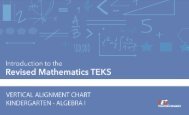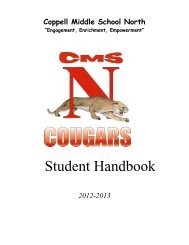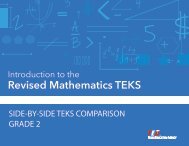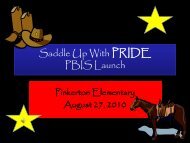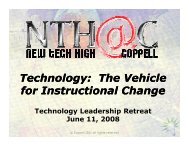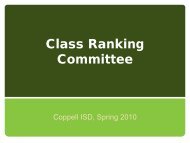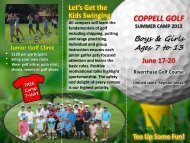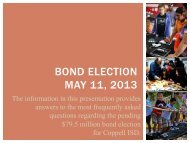SIDE-BY-SIDE TEKS COMPARISON GRADE 3 - Project Share
SIDE-BY-SIDE TEKS COMPARISON GRADE 3 - Project Share
SIDE-BY-SIDE TEKS COMPARISON GRADE 3 - Project Share
You also want an ePaper? Increase the reach of your titles
YUMPU automatically turns print PDFs into web optimized ePapers that Google loves.
Grade 3 – MathematicsCurrent <strong>TEKS</strong> Revised <strong>TEKS</strong> (2012) Supporting Information Notes(a) Introduction.(4) Problem solving, language andcommunication, connections within andoutside mathematics, and formal andinformal reasoning underlie all content areasin mathematics. Throughout mathematics inGrades 3-5, students use these processestogether with technology and othermathematical tools such as manipulativematerials to develop conceptualunderstanding and solve problems as they domathematics.(a) Introduction.(2) The process standards describe waysin which students are expected to engagein the content. The placement of theprocess skill at the beginning of the draftis intentional. The process skills weave theother knowledge and skills together sothat students may be successful problemssolvers and use mathematics efficientlyand effectively in daily life. The processstandards are integrated at every gradelevel and course. When possible, studentswill apply mathematics to problems arisingin everyday life, society, and theworkplace. Students will use a problemsolvingmodel that incorporates analyzinggiven information, formulating a plan orstrategy, determining a solution, justifyingthe solution, and evaluating the problemsolvingprocess and the reasonableness ofthe solution. Students will selectappropriate tools such as real objects,manipulatives, algorithms, paper andpencil, and technology and techniquessuch as mental math, estimation, numbersense, and generalization and abstractionto solve problems. Students willeffectively communicate mathematicalideas, reasoning, and their implicationsusing multiple representations such assymbols, diagrams, graphs, computerprograms, and language. Students willanalyze mathematical relationships toconnect and communicate mathematicalideas. Students will display, explain, orjustify mathematical ideas and argumentsusing precise mathematical language inwritten or oral communication.(a) Introduction.(5) Statements that contain the word"including" reference content that must bemastered, while those containing thephrase "such as" are intended as possibleillustrative examples.This 2012 paragraph occurs second in theRevised <strong>TEKS</strong> (2012) instead of fourth as inthe current <strong>TEKS</strong>. This highlights thecontinued emphasis on process skills thatnow continue from Kindergarten through highschool mathematics.The language of this 2012 introductoryparagraph is very similar to the MathematicalProcess Standard strand within the Revised<strong>TEKS</strong> (2012).This 2012 introductory paragraph includesgeneralization and abstraction with the textfrom (1)(C).This 2012 introductory paragraph includescomputer programs with the text from(1)(D).This 2012 introductory paragraph states,“students will use mathematical relationshipsto generate solutions and make connectionsand predictions.” instead of the text from(1)(E).The State Board of Education approved theretention of some “such as” statements withinthe <strong>TEKS</strong> where needed for clarification ofcontent.©2013 Texas Education Agency. All Rights Reserved 2013 Introduction to the Revised Mathematics <strong>TEKS</strong>: Side-by-Side <strong>TEKS</strong> Comparison 3






